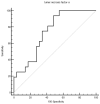Epithelial Antimicrobial Peptide/Protein and Cytokine Expression Profiles Obtained from Nasopharyngeal Swabs of SARS-CoV-2-Infected and Non-Infected Subjects
- PMID: 39339947
- PMCID: PMC11437508
- DOI: 10.3390/v16091471
Epithelial Antimicrobial Peptide/Protein and Cytokine Expression Profiles Obtained from Nasopharyngeal Swabs of SARS-CoV-2-Infected and Non-Infected Subjects
Abstract
Immune responses of the epithelia of the upper respiratory tract are likely crucial in early inhibition of the viral replication and finally clearance of SARS-CoV-2. We aimed to compare the expression profiles of antimicrobial peptides/proteins (AMPs) and related cytokines observed in the nasopharynx of SARS-CoV-2-infected patients and non-infected controls and to assess the associations between these parameters and COVID-19 patients' outcomes. We included 45 subjects who had tested positive for SARS-CoV-2 and 22 control subjects who had tested negative for SARS-CoV-2. Biomaterial for SARS-CoV-2 detection, as well as gene and protein expression studies, was obtained from all subjects using nasopharyngeal swabs which were performed a maximum of 7 days before inclusion in the study. Univariable and multivariable statistics were performed. When compared to the controls, the mRNA expression levels of human β-defensin 1 (hBD-1), LL-37, and trappin-2 were significantly higher in specimens of nasopharyngeal swabs from COVID-19 patients. Protein expression of hBD-1 was also increased in the COVID-19 group. mRNA expression levels of interferon-ɣ (IFN-ɣ), tumor necrosis factor- ɑ (TNF-ɑ), and interleukin-6 (IL-6) measured in SARS-CoV-2-infected patients were significantly higher than those observed in the controls, which could also be confirmed in the protein levels of IFN-ɣ and IL-6. A significant correlation between mRNA and protein levels could be observed only for IL-6. Univariable analysis revealed that low IFN-ɣ mRNA levels were associated with severe/fatal outcomes. The occurrence of COVID-19 pneumonia was significantly associated with lower expression levels of IL-6 mRNA, IFN-ɣ mRNA, and TNF-ɑ mRNA. Concerning the severe/fatal outcomes, the multivariable logistic regression model revealed that none of the aforementioned parameters remained significant in the model. However, the logistic regression model revealed that higher TNF-ɑ mRNA expression was a significant independent predictor of absence of pneumonia [odds ratio: 0.35 (95% CI 0.14 to 0.88, p = 0.024)]. In conclusion, nasopharyngeal expression of AMPs (hBD-1, LL-37, and trappin-2) and cytokines (IL-6, IFN-ɣ, and TNF-ɑ) is upregulated in response to early SARS-CoV-2 infection, indicating that these AMPs and cytokines play a role in the local host defense against the virus. Upregulated nasopharyngeal TNF-ɑ mRNA expression during the early phase of SARS-CoV-2 infection was a significant independent predictor of the absence of COVID-19 pneumonia. Hence, high TNF-ɑ mRNA expression in the nasopharynx appears to be a protective factor for lung complications in COVID-19 patients.
Keywords: COVID-19; RNase-7; S100A7; SALP/elafin; SARS-CoV-2; antimicrobial peptides; antimicrobial proteins; coronavirus; innate immunity; pro-inflammatory cytokines; psoriasin.
Conflict of interest statement
The other authors declare no conflicts of interest.
Figures
Similar articles
-
Age-Related Expression of IFN-λ1 Versus IFN-I and Beta-Defensins in the Nasopharynx of SARS-CoV-2-Infected Individuals.Front Immunol. 2021 Nov 10;12:750279. doi: 10.3389/fimmu.2021.750279. eCollection 2021. Front Immunol. 2021. PMID: 34858406 Free PMC article.
-
High nasopharyngeal and serum IL-6 levels and the - 573G > C polymorphism (rs1800796) are linked with the risk of severe COVID-19 in a Mexican population: a case‒control study.BMC Infect Dis. 2025 Mar 5;25(1):315. doi: 10.1186/s12879-025-10695-y. BMC Infect Dis. 2025. PMID: 40045221 Free PMC article.
-
Transcriptome of nasopharyngeal samples from COVID-19 patients and a comparative analysis with other SARS-CoV-2 infection models reveal disparate host responses against SARS-CoV-2.J Transl Med. 2021 Jan 7;19(1):32. doi: 10.1186/s12967-020-02695-0. J Transl Med. 2021. PMID: 33413422 Free PMC article.
-
Immunological Aspects of SARS-CoV-2 Infection and the Putative Beneficial Role of Vitamin-D.Int J Mol Sci. 2021 May 16;22(10):5251. doi: 10.3390/ijms22105251. Int J Mol Sci. 2021. PMID: 34065735 Free PMC article. Review.
-
Critical Determinants of Cytokine Storm and Type I Interferon Response in COVID-19 Pathogenesis.Clin Microbiol Rev. 2021 May 12;34(3):e00299-20. doi: 10.1128/CMR.00299-20. Print 2021 Jun 16. Clin Microbiol Rev. 2021. PMID: 33980688 Free PMC article. Review.
References
-
- Chen Z., Peng Y., Wu X., Pang B., Yang F., Zheng W., Liu C., Zhang J. Comorbidities and complications of COVID-19 associated with disease severity, progression, and mortality in China with centralized isolation and hospitalization: A systematic review and meta-analysis. Front. Public Health. 2022;10:923485. doi: 10.3389/fpubh.2022.923485. - DOI - PMC - PubMed
-
- Dwivedi T., Raj A., Das N., Gupta R., Gupta N., Tiwari P., Sahoo B., Sagiraju H.K.R., Sirohiya P., Ratre B., et al. The Evaluation of Laboratory Parameters as Predictors of Disease Severity and Mortality in COVID-19 Patients: A Retrospective Study from a Tertiary Care Hospital in India. Cureus. 2023;15:e40273. doi: 10.7759/cureus.40273. - DOI - PMC - PubMed
Publication types
MeSH terms
Substances
LinkOut - more resources
Full Text Sources
Medical
Research Materials
Miscellaneous


